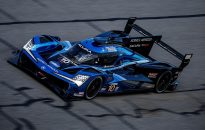Bugatti Chiron Super Sport 300+ At the top of the list sits the Bugatti Chiron Super Sport 300+, a true marvel of engineering that shattered records in 2019 by becoming the first production car to break the 300 mph barrier . This hypercar boasts: Top Speed: 304.773 mph (490.484 km/h) 0-60 mph: 2.4 seconds Horsepower: 1,578 […]
Bugatti Chiron Super Sport 300+
At the top of the list sits the Bugatti Chiron Super Sport 300+, a true marvel of engineering that shattered records in 2019 by becoming the first production car to break the 300 mph barrier
. This hypercar boasts:
- Top Speed: 304.773 mph (490.484 km/h)
- 0-60 mph: 2.4 seconds
- Horsepower: 1,578 hp
The Chiron Super Sport 300+ achieves its mind-boggling speed through a combination of advanced aerodynamics, a quad-turbocharged 8.0-liter W16 engine, and extensive use of lightweight materials. Its sleek design and powerful engine make it a true icon in the world of high-performance automobiles.
Koenigsegg Jesko Absolut
While its top speed remains theoretical, the Koenigsegg Jesko Absolut is poised to potentially become the fastest production car in the world. Koenigsegg claims this hypercar is capable of reaching speeds over 310 mph, though this has yet to be officially tested. The Jesko Absolut features:
- Theoretical Top Speed: Over 310 mph (500 km/h)
- Twin-turbo V8 engine
- Cutting-edge aerodynamics
SSC Tuatara
The SSC Tuatara has had a controversial journey in its quest for the speed crown. While initial claims of reaching 316.11 mph were disputed, the car has since achieved a verified top speed of 295 mph.
Key features include:
- Verified Top Speed: 295 mph (474.8 km/h)
- Twin-turbocharged 5.9-liter engine
- 1,750 horsepower when using E85 ethanol fuel
Hennessey Venom GT
The Hennessey Venom GT, based on a modified Lotus Exige chassis, combines lightweight construction with raw power
- Top Speed: 270.49 mph (435.31 km/h)
- 0-60 mph: 2.7 seconds
- Horsepower: 1,244 hp
Its twin-turbocharged 7.0-liter V8 engine propels this American-made supercar to incredible speeds.
McLaren Speedtail
McLaren’s entry into the hypercar arena, the Speedtail, focuses on aerodynamic efficiency
- Top Speed: 250 mph (402.3 km/h)
- 0-60 mph: 2.9 seconds
- Horsepower: 1,036 hp
The Speedtail’s unique three-seat layout and elongated body contribute to its exceptional performance, combining a hybrid powertrain with cutting-edge aerodynamics.
The Technology Behind the Speed
These hypercars achieve their incredible speeds through a combination of factors:
- Powerful Engines: From Bugatti’s quad-turbocharged W16 to Koenigsegg’s twin-turbo V8, these cars boast some of the most powerful engines ever put into production vehicles.
- Aerodynamics: Extensive wind tunnel testing and computational fluid dynamics help create body shapes that slice through the air with minimal resistance.
- Lightweight Materials: Extensive use of carbon fiber and other lightweight materials helps reduce weight while maintaining structural integrity.
- Advanced Transmissions: Ultra-fast shifting transmissions, like the SSC Tuatara’s seven-speed roboticized CIMA box, help maintain power delivery during acceleration.
- Tire Technology: Special tires designed to withstand extreme speeds and temperatures are crucial for these high-performance vehicles.
The Future of Speed
As we look ahead, the pursuit of speed continues to drive innovation in the automotive industry. Upcoming models like the Tesla Roadster and Koenigsegg Gemera promise to push the boundaries even further, potentially redefining our expectations for hypercar performance. However, it’s important to remember that with great speed comes great responsibility. These incredible machines demand respect both on and off the track, and manufacturers must continue to prioritize safety alongside performance as they push the limits of what’s possible on four wheels.














